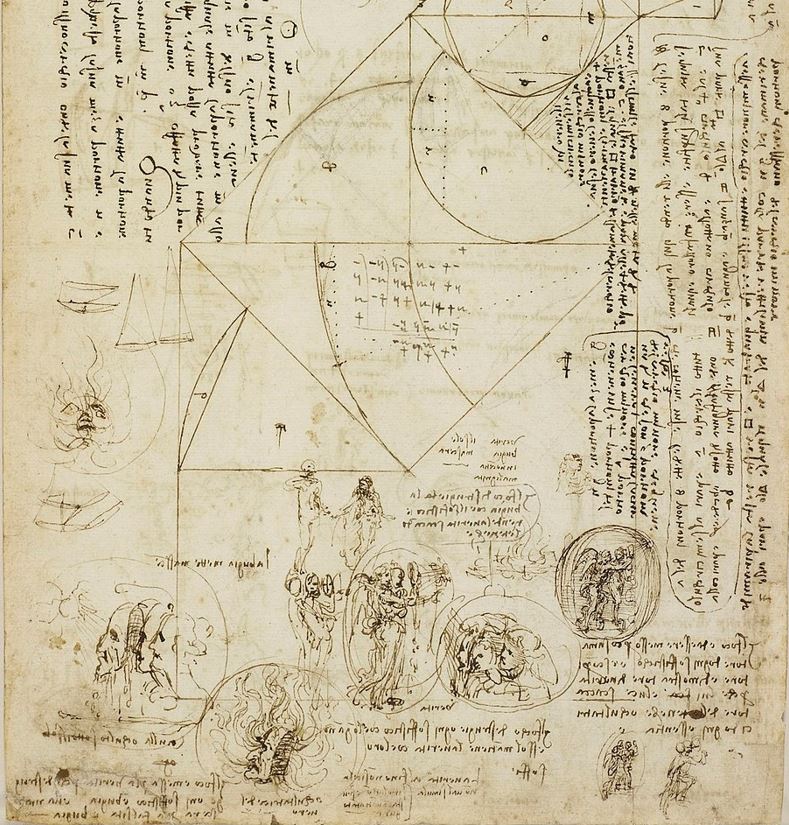The Mindful Mona Lisa: True and False in the Age of Sustainability

Represented by the sun, the fourth sphere of knowledge in the Aristotelian model used widely in Leonardo’s time is Arithmetic: the first of four mathematical disciplines constituting the Quadrivium which also encompasses Geometry (Mars), Music (Jupiter), and Astronomy (Saturn).
The Arithmetica by Diophantus (c. 250 CE) was arguably the first book of algebra, from the Arabic term for “bone-setting” as applied to balancing both sides of equations, though some credit the creation of modern algebra to Al-Khwarizmi (c. 833 CE) from whose name is derived the term “algorithm.”
An intriguing fragment in Leonardo’s notebooks, possibly referencing a character from Boccaccio’s Decameron, confirms his knowledge of this branch of math: “Alberto da Imola -- algebra, that is, the demonstration of the equality of one thing to another" (algebra cioe dimostratione come una cosa s’agguaglia a un altra).
Leonardo saw deep meaning in math, believing it pervaded nature and that the fundamental character of natural phenomena had elements of math at its core.
“Amid the vastness of the things among which we live, the existence of nothingness holds the first place; its function extends over all things that have no existence, and its essence, as regards time, lies precisely between the past and the future, and has nothing in the present. This nothingness has the part equal to the whole, and the whole to the part, the divisible to the indivisible; and the product of the sum is the same whether we divide or multiply, and in addition as in subtraction; as is proved by arithmeticians by their tenth figure which represents zero; and its power has not extension among the things of Nature.”
Optics and vision are another conduit of truth for Leonardo. Comparison of visual pattern, evidence, and experience across diverse realms and integrating that visual information in complex and meaningful forms were the foundations of scientific method:
“The eye, which is called the window of the soul, is the principal means by which the central sense [or sensus communis] can most completely and abundantly appreciate the infinite works of nature; and the ear is the second….”
In this month’s image, along with various numeric notations on the squaring of the circle, Leonardo includes allegorical drawings and emblems about truth. Figures representing true and false appear in masks which over time are consumed by the sun's rays, melting or dissipating in smoke and flame. As he wrote:
“Truth at last cannot be hidden. Dissimulation is of no avail. Dissimulation is to no purpose before so great a judge. Falsehood puts on a mask. Nothing is hidden under the sun.”
“Beyond a doubt truth bears the same relation to falsehood as light to darkness….”
“Truth was the only daughter of Time.”
Leonardo’s emphasis on the aesthetic and scientific centrality of truth starkly contrasts to Machiavelli’s politically oriented assertion (as in the Discourses on Livy) that most princes gain power via fraud, adding that “Although the use of fraud in every action is detestable, nonetheless in managing war it is a praiseworthy and glorious thing….” When politics are, as in Machiavelli’s pessimistic model, war by other means, fraud or deceit may become altogether too prevalent and jeopardize better outcomes, deforming and distorting by their overuse the social sphere which politics require to function.
Reality is binding, despite our capacity for technology and imagination, and learning to live in harmony with nature and among our fellow humans is a virtually mathematical necessity if we are to achieve a resilient politics of sustainability.
Next blog: the sphere of geometry
